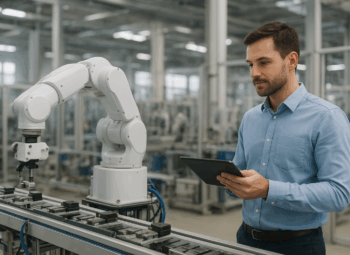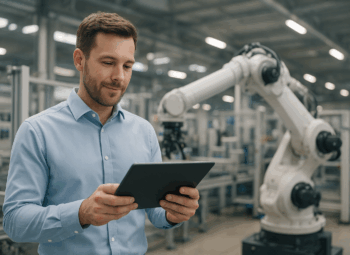Factory teams and supply chain leaders carry heavy mental loads today. Global volatility, compliance pressure, and constant firefighting drive stress and fatigue. Managers jump between supplier vetting, production issues, and customs checks. Workers face repetitive tasks that demand focus and precision. This environment strains well-being and can hurt performance.
AI tools transform how factories operate and how people experience work. They automate routine steps, flag risks early, and guide better decisions. They release time for high-value thinking and reduce task switching. This shift protects mental health while it improves quality, speed, and compliance.
The Prime Sourcing partners with businesses on this change. The firm focuses on international sourcing, carbon neutral supply chains, factory verification, import and export, production optimization, and construction material sourcing. The insights below reflect field experience and applied research. Research Output ID: -1757655619.
AI that supports people and performance in global operations
What pressures AI removes in factories and trade
Operations teams face complex and repetitive work. AI helps by taking on predictable tasks and by surfacing exceptions that need attention. This support lowers cognitive overload and burnout risk.
- Automates routine data entry for purchase orders, packing lists, and customs documents
- Monitors machines and quality in real time to prevent last minute crises
- Scores suppliers on risk and capacity so teams do not recheck the same facts
- Recommends schedules that match labor, materials, and customer priorities
- Flags compliance gaps before audits or shipment holds occur
How AI creates clarity across sourcing to delivery
Factories improve when teams see the same truth. AI stitches data from procurement, production, logistics, and finance. It builds a single picture of status and risk. Managers avoid guesswork and urgent calls across time zones.
- Data fabric links ERP, MES, WMS, quality systems, and supplier portals
- Digital twins simulate demand, capacity, and constraints across plants
- Scenario models show the impact of supplier changes or route delays
- Alerting focuses on exceptions with clear next steps and owners
Benefits for performance and well-being
AI delivers hard results and human benefits at the same time. Leaders can measure outcomes while teams feel more in control.
- Higher first pass yield with fewer reworks and disputes
- Shorter cycle times and more accurate delivery commitments
- Lower overtime and fewer overnight interventions
- Transparent compliance and audit readiness
- Predictable workloads that reduce stress and error risk
AI use cases in sourcing and trade compliance
Verified supplier discovery and factory verification
Finding the right factory takes time and deep checks. AI cuts search time and strengthens verification so buyers move fast with confidence.
- Supplier discovery engines match specs to qualified manufacturers across countries
- Automated document checks validate licenses, certifications, and ESG reports
- Geospatial and satellite data confirm site locations and detect shadow production
- Computer vision compares sample photos to drawings for faster fit checks
- Dynamic scorecards track on-time performance, quality metrics, and corrective actions
The Prime Sourcing integrates these tools with on-the-ground verification. This mix ensures a strong chain of custody and reduces onboarding risk.
Import and export compliance with automation
Trade rules evolve and vary by market. AI reduces manual review and prevents errors that can hold shipments or trigger fines.
- HS code and tariff classification suggestions based on product descriptions and BOM data
- Origin determination and free trade agreement eligibility checks
- Sanctions and restricted party screening across global lists
- UFLPA and forced labor risk signals using supplier networks and region data
- Document generation for invoices, packing lists, and certificates with audit trails
Trade teams review clear recommendations, not confusing rulebooks. This change protects compliance and reduces decision fatigue.
Carbon neutral supply chain planning
Many firms commit to net zero targets. AI helps plan toward carbon neutral supply chains while it controls cost and service.
- Supplier emissions profiles link to sourcing decisions and scorecards
- Route optimization balances lead time, cost, and CO2 impact
- Mode shifting recommendations evaluate sea, rail, air, and road tradeoffs
- Material substitution suggestions reduce embodied carbon in products
- Automated reporting supports GHG Protocol scopes and audit requests
Teams align ESG goals with operations. They make choices that lower emissions and reduce stress from last minute compliance demands.
AI for production optimization on the factory floor
Predictive maintenance that prevents downtime
Unplanned stops raise costs and create chaos. AI models analyze sensor data to predict failures before they occur. Planners schedule short, targeted interventions and avoid major breakdowns.
- Real time monitoring of vibration, temperature, and power draw
- Failure pattern detection for critical equipment
- Maintenance recommendations with parts and labor plans
- Inventory signals to pre-position spares across plants
This approach stabilizes production and reduces emergency work, which helps protect worker focus and safety.
Quality intelligence with computer vision
Quality checks often rely on tired eyes and long shifts. AI vision systems inspect parts and assemblies with consistent accuracy. They catch defects early and suggest corrective actions.
- Inline cameras detect surface flaws, incorrect labels, and assembly gaps
- Automated sampling plans adjust by risk and defect history
- Root cause analysis ties defects to process conditions and materials
- Supplier feedback loops improve incoming quality
Teams shift from rework to prevention. Buyers gain confidence that orders meet spec on the first run.
Scheduling, inventory, and throughput optimization
Complex schedules strain planners and operators. AI builds feasible plans that reflect real constraints and service goals.
- Finite scheduling aligns machines, tools, and skills
- Dynamic safety stocks protect service without bloating inventory
- Demand sensing refines forecasts using order patterns and seasonality
- What-if planning for changeovers, overtime, and subcontracting
Production runs smoother. Materials arrive when needed. Teams handle fewer escalations and fewer late changes.
AI-driven sourcing for construction materials
Dealing with price swings and lead time shocks
Construction supply chains face frequent volatility. AI reads market signals and supports stable planning.
- Price forecasting for steel, cement, lumber, and composites
- Supplier capacity visibility with early warnings on bottlenecks
- Multi-sourcing strategies that reduce single point risk
- Freight and port congestion prediction to avoid delays
Project managers commit to dates and budgets with more confidence. They reduce stress on site teams and contractors.
Compliance and sustainability in materials
Regulations and client standards grow stricter. AI helps choose materials and suppliers that meet environmental and safety rules.
- Environmental product declaration parsing and scoring
- Legal compliance checks for REACH, RoHS, and country standards
- Digital product passport readiness for future regulations
- Traceability from raw material to installed component
The Prime Sourcing guides material selection with verified data. This approach safeguards compliance, bids, and reputation.
Risk management across project lifecycles
Construction projects face supply, weather, and labor risks. AI maps these risks and supports contingency plans.
- Supplier financial health monitoring and early alerts
- Scenario planning for extreme weather and site access
- Buffer strategies for long lead items and critical path elements
- Contract alignment on INCOTERMS, insurance, and delivery windows
Project teams avoid costly surprises. They protect worker morale by reducing crises that demand weekend or overnight work.
Implementation roadmap and governance for AI in factories
Build the right data and security foundation
AI succeeds with clean data and strong controls. Start small, link systems, and protect sensitive information.
- Define data owners for procurement, quality, production, and logistics
- Standardize master data for parts, specs, suppliers, and machines
- Use secure connectors and role-based access across systems
- Deploy MLOps practices to monitor model drift and bias
- Document audit trails for decisions and trade filings
Put people at the center of change
AI should reduce stress, not add noise. Design workflows that fit the way teams work and support mental health.
- Map tasks and remove low-value steps before automation
- Deliver simple, action-oriented alerts with clear owners
- Train users with real examples from their lines and suppliers
- Set healthy alert thresholds to prevent alarm fatigue
- Offer well-being support and predictable shift patterns
Measure what matters and scale
Leaders should track outcomes, not vanity metrics. Choose KPIs that link to customer value, compliance, and team health.
- Quality: first pass yield, customer complaints, supplier defect rates
- Delivery: on-time in-full, cycle time, schedule adherence
- Cost: scrap, rework, expedite fees, energy use
- Compliance: audit findings closed, document accuracy, holds avoided
- People: overtime hours, alert fatigue index, safety incidents
Scale by reusing data models and playbooks across sites. Keep governance simple and review models on a fixed cadence.
Actionable next steps for AI-enabled, carbon smart factories
Start with one high-value, low-complexity use case
Focus on a pain point that drains team energy and hits performance. Good first moves include vision-based quality checks on a top SKU, HS code classification support for a busy product family, or predictive maintenance on a critical machine cell.
- Define the business goal and the team goal, such as fewer reworks and fewer after-hours calls
- Collect sample data and label it with operations experts
- Pilot for 8 to 12 weeks with clear success criteria
- Document the new workflow and train shift leaders
Integrate sustainability from day one
Treat emissions as a managed constraint, not an afterthought. Include emissions factors and route options in sourcing and planning models. Ask suppliers for transparent data and link it to scorecards.
- Baseline current emissions for selected lanes and parts
- Identify quick wins such as mode shifts and consolidation
- Build supplier improvement plans with shared milestones
- Report progress in a simple dashboard for leadership and clients
Partner with experts who blend tech and trade
AI in factories touches sourcing, production, logistics, and legal. Teams win when technology experts and trade consultants work together. The Prime Sourcing brings this blend with global supplier networks, factory verification, and hands-on production optimization.
- Coordinate data, process, and compliance streams from the start
- Embed change management and worker safety practices
- Align contracts and INCOTERMS to the new operating model
- Plan for audit readiness and continuous improvement
AI tools now reshape factory operations and global sourcing. They deliver speed, quality, and compliance while they protect the people who make supply chains work. Leaders who act now build resilient, carbon smart operations and a healthier workplace.






